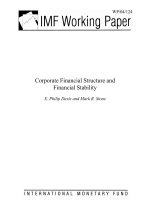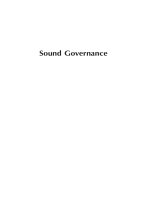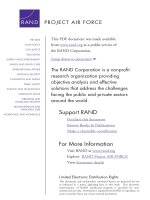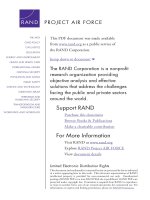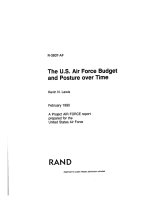Air Force Physician and Dentist Multiyear Special Pay - Current Status and Potential Reforms ppt
Bạn đang xem bản rút gọn của tài liệu. Xem và tải ngay bản đầy đủ của tài liệu tại đây (702.85 KB, 148 trang )
This document and trademark(s) contained herein are protected by law as indicated
in a notice appearing later in this work. This electronic representation of RAND
intellectual property is provided for non-commercial use only. Unauthorized
posting of RAND PDFs to a non-RAND Web site is prohibited. RAND PDFs are
protected under copyright law. Permission is required from RAND to reproduce,
or reuse in another form, any of our research documents for commercial use. For
information on reprint and linking permissions, please see RAND Permissions.
Limited Electronic Distribution Rights
Visit RAND at www.rand.org
Explore RAND Project AIR FORCE
View document details
For More Information
This PDF document was made available
from www.rand.org as a public service of
the RAND Corporation.
6
Jump down to document
THE ARTS
CHILD POLICY
CIVIL JUSTICE
EDUCATION
ENERGY AND ENVIRONMENT
HEALTH AND HEALTH CARE
INTERNATIONAL AFFAIRS
NATIONAL SECURITY
POPULATION AND AGING
PUBLIC SAFETY
SCIENCE AND TECHNOLOGY
SUBSTANCE ABUSE
TERRORISM AND
HOMELAND SECURITY
TRANSPORTATION AND
INFRASTRUCTURE
WORKFORCE AND WORKPLACE
The RAND Corporation is a nonprofit
research organization providing
objective analysis and effective
solutions that address the challenges
facing the public and private sectors
around the world.
Purchase this document
Browse Books & Publications
Make a charitable contribution
Support RAND
This product is part of the RAND Corporation monograph series.
RAND monographs present major research findings that address the
challenges facing the public and private sectors. All RAND mono-
graphs undergo rigorous peer review to ensure high standards for
research quality and objectivity.
Edward G. Keating, Marygail K. Brauner, Lionel A. Galway,
Judith D. Mele, James J. Burks, Brendan Saloner
Prepared for the United States Air Force
Approved for public release; distribution unlimited
PROJECT AIR FORCE
Air Force
Physician and Dentist
Multiyear Special Pay
Current Status and Potential Reforms
The RAND Corporation is a nonprofit research organization providing
objective analysis and effective solutions that address the challenges facing
the public and private sectors around the world. RAND’s publications do
not necessarily reflect the opinions of its research clients and sponsors.
R
®
is a registered trademark.
© Copyright 2009 RAND Corporation
Permission is given to duplicate this document for personal use only, as long
as it is unaltered and complete. Copies may not be duplicated for commercial
purposes. Unauthorized posting of RAND documents to a non-RAND
Web site is prohibited. RAND documents are protected under copyright law.
For information on reprint and linking permissions, please visit the RAND
permissions page ( />Published 2009 by the RAND Corporation
1776 Main Street, P.O. Box 2138, Santa Monica, CA 90407-2138
1200 South Hayes Street, Arlington, VA 22202-5050
4570 Fifth Avenue, Suite 600, Pittsburgh, PA 15213-2665
RAND URL:
To order RAND documents or to obtain additional information, contact
Distribution Services: Telephone: (310) 451-7002;
Fax: (310) 451-6915; Email:
The research described in this report was sponsored by the United States
Air Force under Contract FA7014-06-C-0001. Further information may
be obtained from the Strategic Planning Division, Directorate of Plans,
Hq USAF.
Library of Congress Cataloging-in-Publication Data is available for this publication.
ISBN 978-0-8330-4697-0
iii
Preface
is monograph emanates from a RAND Project AIR FORCE study
entitled “Optimizing Medical and Dental Officer Accession and Reten-
tion Incentives.” is fiscal year (FY) 2008 study was jointly sponsored
by the Director of Force Management Policy, Deputy Chief of Staff,
Manpower and Personnel (AF/A1P), and the Assistant Surgeon Gen-
eral for Medical Force Development, Office of the Air Force Surgeon
General (AF/SG1). e study’s objective was to examine options for Air
Force medical and dental officer incentive bonuses.
In the monograph, we present trends in accession, retention, and
promotion in the Medical and Dental Corps and discuss Multiyear
Special Pay (MSP) and observed tendencies of physicians and dentists
to accept MSP. A series of estimations that we undertook to calibrate
how physicians respond to higher MSP levels has been put into an
appendix in the interest of streamlining the narrative flow of the body
of the monograph.
Related RAND Corporation documents include the following:
Retention of Volunteer Physicians in the U.S. Air Force,t by Victoria
L. Daubert (R-3185-AF), 1985.
I Want You! e Evolution of the All-Volunteer Force, t by Bernard
Rostker (MG-265-RC), 2006.
e Dynamic Retention Model for Air Force Officers: New Estimates t
and Policy Simulations of the Aviator Continuation Pay Program,
by Michael Mattock and Jeremy Arkes (TR-470-AF), 2007.
iv Air Force Physician and Dentist Multiyear Special Pay
is research is intended to be of interest to Air Force and other
Department of Defense personnel involved with military personnel
compensation policy and health affairs issues.
RAND Project AIR FORCE
RAND Project AIR FORCE (PAF), a division of the RAND Cor-
poration, is the U.S. Air Force’s federally funded research and devel-
opment center for studies and analyses. PAF provides the Air Force
with independent analyses of policy alternatives affecting the devel-
opment, employment, combat readiness, and support of current and
future aerospace forces. Research is conducted in four programs: Force
Modernization and Employment; Manpower, Personnel, and Train-
ing; Resource Management; and Strategy and Doctrine. e research
reported here was performed within the Manpower, Personnel, and
Training Program.
Additional information about PAF is available on our Web site:
/>v
Contents
Preface iii
Figures
vii
Tables
xi
Summary
xiii
Acknowledgments
xxi
Abbreviations
xxiii
CHAPTER ONE
Introduction 1
Physician Compensation
9
Dentist Compensation
11
CHAPTER TWO
Trends in Accession, Retention, and Promotion in the Air Force
Medical Corps, 1976–2007
15
Patterns in Medical Corps Accessions
16
Medical Corps Retention
23
Medical Corps Promotion
31
CHAPTER THREE
Physician Cohort Analysis 37
CHAPTER FOUR
Trends in Accession, Retention, and Promotion in the Air Force
Dental Corps, 1976–2007
49
Patterns in Dental Corps Accessions
49
vi Air Force Physician and Dentist Multiyear Special Pay
Dental Corps Retention 54
Dental Corps Promotion
60
CHAPTER FIVE
Dentist Cohort Analysis 65
CHAPTER SIX
Conclusions 71
APPENDIXES
A. Estimating a Physician’s or Dentist’s Eligibility for Multiyear
Special Pay
77
B. Air Force Medical and Dental Special Pays, 1992–2009
81
C. Logistic Regression Analysis of Physician Multiyear Special
Pay Acceptance
93
D. Using the Dynamic Retention Model
105
References
119
vii
Figures
1.1. Air Force Medical and Dental Corps Total Populations 2
1.2. Air Force Medical and Dental Corps Annual Accessions
3
1.3. Percentage of Accessions with Prior Active Duty
Non–Medical Corps Air Force Experience
6
1.4. Annual Attrition Rates, Medical and Dental Corps
8
2.1. Changing Accession Sources of Medical Corps Entrants,
1978–2000
17
2.2. Annual Medical Corps and Air Force Active Duty Force
Size, 1975–2007
19
2.3. Female Graduates of U.S. Medical Schools, Entry of
Women into the Medical Corps, and Women in the
Air Force Officer Corps, 1975–2007
20
2.4. Percentage of Medical Corps Majors Promoted to
Lieutenant Colonel in Less an Six Years, Six Years,
or More an Six Years, by Accession Source,
1978–1988
33
2.5. Percentage of Medical Corps Lieutenant Colonels
Promoted to Colonel in Less an Six Years, Six Years,
or More an Six Years, by Accession Source, 1978–1988
34
2.6. Percentage of Physicians Retiring in Year, Conditional on
Staying for More an 19 Years, 1978–1988 Entering
Cohorts
35
3.1. Physicians Entering Air Force Service With and Without
Completed Civilian Residencies
38
3.2. Retention Rates of FY89 Cohort Physicians Who
Completed Civilian Residencies Versus Physicians Who
Had Not
39
viii Air Force Physician and Dentist Multiyear Special Pay
3.3. Years at FY89 Entering Cohort Physicians Became
Eligible for MSP
42
3.4. FY89 Entering Cohort Physician MSP Acceptance Rates,
by First Year of MSP Eligibility
44
3.5. MSP Acceptance Rates, by Physician Entering Cohort
and Eligibility Timing
45
3.6. Physician MSP Acceptance Rates, by First Year of
Eligibility and Eligibility Timing
46
4.1. Changing Accession Sources of Dental Corps Entrants,
1978–2000
50
4.2. Annual Dental Corps and Air Force Active Duty Force
Size, 1975–2007
51
4.3. Female Graduates of U.S. Dental Schools, Entry of
Women into the Dental Corps, and Women in the
Air Force Officer Corps, 1975–2007
53
4.4. Dental Corps HPSP and Direct-Accession Entrants’
Seven-Year Retention Percentages
56
4.5. Percentage Retention of Dental Corps at ree, Seven,
and Nineteen Years, 1978–2004 Entrants
57
4.6. Percentage of Dentists Retiring in Each Year of Service,
Conditional on Staying for More an 19 Years,
1978–1988 Entering Cohorts
64
5.1. MSP Acceptance Rates of Eligible Officers, by Entering
Cohort
65
5.2. 1995–2000 Entering Cohort DOMRB-Eligible Dentist
Acceptance Rates, by Specialty
66
5.3. 1995–2000 Entering Cohort Dentists and eir MSP
Status, as of September 30, 2007
67
5.4. Percentage of Dentists and Physicians Who Have Accepted
MSP, by Entering Cohort
68
5.5. Percentage of Dental Corps Officers Within One Year
of Service Commitment Expiration
69
6.1. Air Force Medical Corps Steady-State Calculations
73
6.2. Air Force Dental Corps Steady-State Calculations
74
C.1. Predicted MSP Acceptance for All MSP-Eligible Physicians,
1989–2004 Cohorts
98
C.2. Percentage of Four-Year Special Pay Observations
99
C.3. Predicted Four-Year MSP Acceptance for Surgeons and
Family Practice Physicians, 1989–2004 Cohorts
100
Figures ix
C.4. Percentage of Four-Year Special Pay Observations for
Family Practice Physicians and Surgeons
101
D.1. Taste Distributions
114
D.2. Shock Distributions
115
xi
Tables
S.1. Summary of Findings and Recommendations xix
2.1. 1978–2000 Medical Corps Entrants, by Finishing
Specialty
24
2.2. Medical Corps Tenure Length, by Accession Source and
Residency, 1978–1988 Entrants
26
2.3. Tenure of HPSP Military Resident Entrants, by Race,
Gender, and Entering Specialty, 1978–1988
28
2.4. Tenure of HPSP Civilian Resident Entrants, by Race,
Gender, and Entering Specialty, 1978–1988
29
4.1. 1978–2000 Entering Dental Officers and General Clinical
Dentists, by Finishing Specialty
55
4.2. Dental Corps Retention at ree, Seven, and Nineteen
Years, by Gender, Race, and Final AFSC
59
6.1. Summary of Findings and Recommendations
75
B.1. Emergency Medicine, Family Practice, and Internal
Medicine Annual MSP
82
B.2. OB/Gyn, Pediatrics, and Surgery Annual MSP
83
B.3. Emergency Medicine, Family Practice, Internal Medicine,
OB/Gyn, Pediatrics, and Surgery Annual Incentive
Special Pay
84
B.4. Physician Variable Special Pay
85
B.5. Physician Board-Certified Pay
86
B.6. Advanced Clinical Dentist, Comprehensive Dentist,
and Oral Surgeon Annual MSP
87
B.7. Orthodontist, Periodontist, and Prosthodontist Annual
MSP
88
B.8. Dental Corps Additional Special Pay
89
xii Air Force Physician and Dentist Multiyear Special Pay
B.9. Dental Corps Variable Special Pay 90
B.10. Dental Corps Board-Certified Pay
91
B.11. Converting en-Year Dollars to Constant FY07 Dollars
91
C.1. Family Practice and Surgery Annual MSP Levels
94
C.2. Logistic Regression Results
96
D.1. Estimated Parameters for Shock and Taste Distributions
for Air Force Family Practice MDs and Pilots
114
xiii
Summary
Since the advent of the all-volunteer force, the U.S. military has strug-
gled with how best to attract and retain physicians and dentists. As
of September 30, 2007, there were approximately 3,400 physicians in
the Air Force’s Medical Corps and 900 dentists in its Dental Corps.
Both populations have declined in recent years. e Air Force Medi-
cal Corps has had a pattern of decreasing annual accessions that dates
back to 1990. Dental Corps accessions, however, have been variable
from year to year.
e Air Force’s three largest Medical and Dental Corps acces-
sion paths all involve sizable lags between an individual’s commitment
to serve in the Air Force and actual provision of trained medical or
dental services. e foremost accession tool is the Health Professions
Scholarship Program (HPSP), in which the military pays for medical
or dental school tuition, books, and fees and provides a monthly sti-
pend to the student in exchange for a one-for-one service commitment.
A related accession program is the Financial Assistance Program (FAP),
in which the military provides a stipend to a non-HPSP physician in a
civilian residency program in exchange for postresidency military ser-
vice by that physician. e Department of Defense also operates the
Uniformed Services University of Health Sciences (USUHS) medical
school. USUHS students do not pay tuition and receive a stipend while
at USUHS but then owe a post-USUHS seven-year service commit-
ment (not counting time spent in residency training).
Since 1975, Air Force Medical Corps annual attrition has gener-
ally been greater than Dental Corps attrition, but the opposite has been
true in recent years. Medical Corps attrition has trended downward
xiv Air Force Physician and Dentist Multiyear Special Pay
in recent years, while Dental Corps attrition (though highly variable
from year to year) has trended upward. Our analysis suggests that the
Medical Corps’ downward population trend has largely been caused
by accession reductions, while the Dental Corps’ foremost recent chal-
lenge has been retention. (See pp. 7–8.)
Physicians and dentists in the military are officers. Along with the
compensation that an officer of a given rank receives, Air Force physi-
cians and dentists are eligible for a variety of special pays. ese spe-
cial pays include Additional Special Pay, Variable Special Pay, Board-
Certified Pay, Incentive Special Pay, and MSP. MSP is the focus of this
monograph. Under this program, qualifying physicians and dentists
who make two-, three-, or four-year commitments to additional service
receive additional annual payments. e Air Force asked RAND to
describe the tendencies of physicians and dentists to accept MSP.
Trends in Accession, Retention, and Promotion in the Air
Force Medical Corps (1976–2007)
We examined the service records of physicians in the Air Force Medi-
cal Corps from 1976 to 2007. ree major trends in Medical Corps
accession sources are noteworthy. First, beginning in the early 1980s,
HPSP produced the vast majority of physicians, 60–80 percent of all
entrants. Second, direct accessions, who made up more than one quar-
ter of all entrants in the first few years of the all-volunteer force, had
virtually disappeared by the end of the study period. ird, USUHS
emerged as a stable accession source, contributing just over 8 percent of
all entrants in most years. (See pp. 16–17.)
e racial and gender composition of Air Force physicians has
changed considerably over time, corresponding to the increased entry
of females and minorities into both the civilian physician labor market
and into the Air Force Officer Corps more broadly. (See pp. 18–21.)
e data suggest that many physicians retrained and upgraded
their skills while in the Medical Corps. (See pp. 22–25.)
We also found that, in virtually every accession category, the
majority of entering physicians did not stay beyond their minimum
Summary xv
service obligations. e exception was USUHS graduates, who were
just as likely to stay for more than 20 years as to leave after the end of
their estimated minimum service obligations. For HPSP, the largest
accession group, completing a military residency was associated with
a roughly three times greater probability of staying for more than 20
years relative to those who had completed a civilian residency. (See pp.
23, 26.)
Beyond accession source, race and specialty were also correlated
with retention. In particular, African Americans, Hispanics, and Native
Americans stayed, on average, more than three years longer than did
white non-Hispanic physicians (after controlling for accession source).
More highly compensated specialties, such as surgery, obstetrics, and
orthopedics, also tended to have shorter retentions than did general and
internal medicine specialties. After controlling for residency length, the
group with the longest retention was aerospace medicine physicians.
is population was probably attracted to military service in the first
place and sought a residency in a field that would allow for this kind of
a career. e entering specialty with the highest 20-year retention rate
was pediatricians. (See pp. 26–30.)
In general, physicians who pursued residencies in the military
had much higher retention and also faster promotions. Graduates of
the HPSP program who completed military residencies were promoted
from both major to lieutenant colonel and from lieutenant colonel to
colonel more quickly than their HPSP civilian residency counterparts.
e underlying cause of this difference is not clear. (See pp. 31–35.)
To the extent that promotion speed differences might be attribut-
able to behavioral differences in these populations, it could be a reflec-
tion of differences in commitment to military service of the two groups.
e HPSP graduates who were more interested in civilian careers may
have self-selected themselves into civilian residencies. An alternative,
although not mutually exclusive, explanation is that military residen-
cies helped transition physicians into the military’s culture. Regardless
of a physician’s taste for military service when he or she was selecting a
residency, those who entered military residencies had a greater oppor-
tunity to become acculturated to the expectations and roles of a physi-
cian in the Air Force Medical Corps.
xvi Air Force Physician and Dentist Multiyear Special Pay
Physician Cohort Analysis
To study physician predilection to accept MSP, we focused on enter-
ing cohorts of physicians. For instance, a physician would be in the
1989 entering cohort if his or her first Air Force service as a physician
occurred during FY89.
While members of an entering cohort share their first year of ser-
vice as Air Force physicians, intracohort heterogeneity remains consid-
erable. Along with having different medical specialties, some members
of an entering cohort have already completed civilian residency pro-
grams, while others are just starting military residency programs.
Physicians who enter Air Force service having already completed a
civilian residency are typically just three or four years away from being
eligible to leave the Air Force. By contrast, a physician whose first ser-
vice is as a military resident is many more years away from fulfilling
his or her service obligation, since years in a military residency do not
count toward educational obligation fulfillment. Indeed, data confirm
that physicians who enter the Air Force with completed residencies
depart Air Force service at a much faster rate. (See pp. 39–40.)
To qualify for MSP, a physician must have
completed appropriate residency training (civilian or military)t
at least eight years of creditable service OR completed any active duty t
service obligation incurred for medical education and training.
We estimated when individuals became eligible for MSP on a
physician-by-physician basis. A typical physician entering cohort has
two peaks of MSP eligibility attainment. e first peak occurs after
three to four years when civilian residency–completing physicians
fulfill their initial obligation to the Air Force. We label this popula-
tion “early eligibles.” e second peak occurs seven to eight years after
entrance when military residency–completing physicians either fulfill
their initial obligation or complete eight years of service. We label this
population “later eligibles.” “Later eligible” physicians have accepted
MSP at much greater rates than “early eligible” physicians. ere has,
Summary xvii
however, been an upturn in recent cohorts’ early eligible MSP accep-
tance rates. (See pp. 44–47.)
Trends in Accession, Retention, and Promotion in the Air
Force Dental Corps (1976–2007)
Unlike physicians, who have many different accession sources and
specialties, Air Force dentists are a more homogeneous group. Most
dentists during the study period were direct accessions (particularly
in the early years that were the subject of the retention and promotion
analyses). is trend was reversed toward the end of the study period,
in which HPSP graduates became the most common accession source.
Dentists also had fewer specialties than physicians; for the most part,
the Dental Corps was dominated by generalists. Although generalists
did predominate, many of them continued their training while in the
Dental Corps. One-third to one-half of dentists who entered in a non-
residency field left with a residency completed. (See pp. 49–55.)
e retention of dentists was relatively high. A dentist entering
the Dental Corps at the beginning of the study period had a great-
er than 60-percent chance of staying for longer than three years, greater
than 40-percent chance of staying for longer than seven years, and
greater than 20-percent chance of staying for longer than 19 years. Over
time, however, retention at every experience level decreased. e cause
of this decrease is not clear. It does correspond to the entry of HPSP
graduates, but this association is not necessarily causal. Decreased reten-
tion has led to a shrinking of the Dental Corps. (See pp. 54, 56–58.)
e retention of underrepresented minorities was somewhat higher
than that of white non-Hispanic dentists. Women had lower observed
retention, especially at seven years of service. (See pp. 58–60.)
Promotion for dentists followed quite predictable promotion
points. Promotion from captain to major, major to lieutenant colonel,
and lieutenant colonel to colonel each most often happened at six-year
intervals. Consistent with this pattern, more than half of all colonels
were promoted in their 18th year. We found some evidence of differ-
ential promotion by gender and race in the earlier cohorts. However,
xviii Air Force Physician and Dentist Multiyear Special Pay
these findings were based on small samples and are not adjusted for
entry year, so it remains an open question whether this association
would hold with more careful statistical controls. (See pp 60–63.)
Because many of the retention and promotion findings in our
analysis were restricted to entry years from 1978 to 1988 (to avoid
truncation and censoring problems), they may not generalize to later
cohorts.
Dentist Cohort Analysis
Dentists’ responses to MSP opportunities have been very different from
those of physicians. Conditional on becoming eligible for MSP, dentists
have accepted such pay (the Dental Officer Multiyear Retention Bonus
[DOMRB]) at much greater rates than physicians have. (See p. 65.)
However, most Air Force dentists have not completed residencies that
would make them eligible for MSP/DOMRB. (See p. 67.) While the
DOMRB has had no clear effect on dentist attrition (which has been
trending up), it has sharply reduced the percentage of Air Force dentists
who are within one year of the expiration of their service commitment.
(See pp. 69–70.)
Conclusions
In the short run, the major accession flows into the Air Force Medi-
cal and Dental Corps (HPSP, USUHS, and FAP) are predetermined.
erefore, if the Air Force wants to increase the Medical or Dental
Corps populations, the only clear-cut short-run tactic would be to
reduce the attrition rate of physicians and dentists whose service com-
mitments are about to expire. (See p. 71.)
MSP is intended to keep physicians and dentists in the Air Force
after their initial service obligations have expired. MSP has been suc-
cessful in that eligible dentists, in particular, have often accepted it.
Most eligible physicians have heretofore refused MSP, but physicians
in some subpopulations, e.g., those who received residency training
Summary xix
at military medical centers, have shown growing inclination to accept
MSP. Increasing MSP levels appears to increase the percentage of phy-
sicians who choose to accept MSP rather than leaving Air Force ser-
vice. (See p. 72.)
Both the Medical Corps and Dental Corps have had accession
totals and attrition rates in recent years that will not sustain the corps’
current sizes. Unless the Air Force wants these corps to continue to
shrink, steps must be taken to either increase accessions or reduce attri-
tion. (See pp. 72–74.)
We recommend the Air Force focus on increasing Medical Corps
accessions. Still further increases in MSP could further reduce Medical
Corps attrition, but the result would be an increasingly senior Medi-
cal Corps over time. If the Air Force wishes to maintain its current
Medical Corps seniority structure, accessions must be increased or at
least stabilized. (See pp. 73–74.)
We urge the Air Force to consider retention bonuses for dentists
who have not yet completed residencies that make them eligible for
DOMRB. Dental Corps accessions have been variable from year to
year but have not shown the consistent diminution seen in the Medical
Corps. DOMRB-eligible dentists are being retained at a high rate. e
hole in the Dental Corps’ portfolio lies in retaining dentists who have
not completed DOMRB-qualifying residencies. (See p. 74.)
Table S.1 summarizes our findings and recommendations.
Table S.1
Summary of Findings and Recommendations
Category Physicians Dentists
Accessions Trending downward Static
Attrition Near historic lows Variable but trending up
Acceptance of
MSP/DOMRB
Increased in recent
years
About 50%, conditional on
eligibility
Recommendation Focus on increasing
accessions
Increase retention
incentives for dentists not
eligible for DOMRB
xxi
Acknowledgments
e authors appreciate the assistance of personnel in our sponsors’
offices: John Park, Lt Col Eric Johnson, Lt Col Helen Meisenhelder,
Maj James Cordeiro, and Maj Todd Sriver of AF/A1 and Col Grant
Hartup, Col Arynce Pock, Lt Col omas Cheatham, Maj Erica Auer-
bach, and Maj Kate Morganti of AF/SG1.
We benefited from an April 24, 2008, visit to the Air Force Per-
sonnel Center and the Air Force Recruiting Service at Randolph Air
Force Base. ere, we met with experts including Col Phillip Sandefur,
Lt Col Stephen Greentree, Maj Risa Riepma, Capt (now Maj) Robert
Corby, Gerald Ball, and Dayan Geiger.
Darlena Ridler and Matthew Torres of the Defense Manpower
Data Center provided assistance with pay file data. Collins Mikesell of
the American Association of Medical Colleges provided a valuable data
extract to the authors. Denise Anderson of USUHS provided informa-
tion on their students’ backgrounds.
We received constructive reviews of an earlier draft of this docu-
ment from Daniel Cohen of USUHS and our RAND colleague James
Hosek. Cynthia Cook and Margaret Lada orchestrated the Project AIR
FORCE document review process.
We appreciate the assistance of our RAND colleagues, includ-
ing program director Al Robbert, deputy program director Bart Ben-
nett, and former deputy program director Larry Hanser. Edward Chan
and Christine Eibner noted relevant literature. Jack Graser provided
a number of constructive suggestions that improved the document.
Susan Hosek gave us a number of valuable insights about the military
medical system. Craig Martin provided programming assistance and
xxii Air Force Physician and Dentist Multiyear Special Pay
Gary Massey provided insights on the data. Michael Mattock assisted
in the estimations described in Appendix D. Laura Miller provided
insight on female participation in the Air Force Officer Corps, and
Ben Mundell gave us insights on Air Force career paths. Lt Col Hans
Ritschard provided background on policies and career paths within the
Medical Corps. Roberta Shanman, Tomiko Envela, and Brooke Hyatt
provided literature search assistance. Jane Siegel helped prepare this
document. Miriam Polon edited this document.
While this paper was being finalized, Al Robbert’s administrative
assistant, Susan Bowen, passed away. We miss her greatly.
Of course, any remaining errors are solely the authors’ responsi-
bility.
xxiii
Abbreviations
ACOL Annualized Cost of Leaving
ADSCD Active Duty Service Commitment Date
AF Air Force
AF/A1P U.S. Air Force Deputy Chief of Staff, Manpower
and Personnel, Director of Force Management
Policy
AFPC Air Force Personnel Center
AFSC Air Force Specialty Code
AF/SG1 U.S. Air Force Surgeon General, Assistant Surgeon
General for Medical Force Development
BFGS Broyden-Fletcher-Goldfarb-Shanno
DAFSC Duty Air Force Specialty Code
DMDC Defense Manpower Data Center
DoD U.S. Department of Defense
DOMRB Dental Officer Multiyear Retention Bonus
(the Dental Corps’ version of MSP)
DOPMA Defense Officer Personnel Management Act
DRM Dynamic Retention Model
ENT ear, nose, throat
FAP Financial Assistance Program
FY fiscal year

